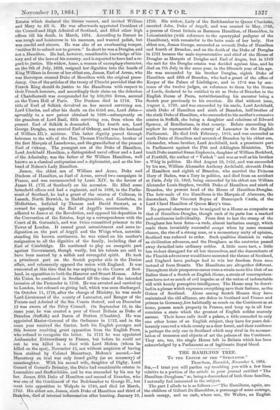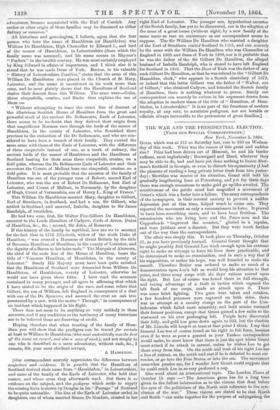THE HAMILTON TREE.
To THE EDITOR OF THE "SPECTATOR."
Taverham, Norwich, November 4, 1864. SIE,-I trust you will pardon my troubling you with a few lines relative to a portion of the article in your journal entitled "The Hamilton-Douglases," as, being a descendant of both those families, I naturally feel interested in the subject. 'I'he part I allude to is as follows :—" The Hamiltons, again, are the children of Gilbert De Hameldun, a personage of some courage, much energy, and no cash, whose son, Sir Walter, an English
adventurer, became acquainted with the Earl of Carrick. Any earlier or other origin of these families may be dismissed as either flattery or romance."
All historians and genealogists, I believe, agree that the first person who bore the name of Hambleton (or Hatnbledon) was William De Hambleton, High Chancellor to Edward I., and lord
ef the manor of Hambleton, in Leicestershire (from which the family, name was assumed), -and his name occurs in Rhymer's " Fcedem " in the twelfth century. He was most certainly employed by King Edward in affairs of importance, and I think also it is Stated that he was made Dean of York. Burton, in his valuable ,1 History of Leicestershire Families," states that the arms of this William De Hambleton were placed in the Church of St Mary, Leicester, and the name is mentioned in his work more than once, and he most plainly shows that the Hamilton's of Scotland derive their descent from this William. The arms were—Gtdes, three cinquefoils, ermine, and Burke thus explains the use of "them :— 0 Without attempting to trace the exact line of descent of the illustrious Scottish House of Hamilton from the great and powerful stock of the ancient De Bellamonts, Earls of Leicester, there seems to be no doubt that they derived their origin from that magnificent Norman race through the lords of the manor of Hambleton, in the county of Leicester, who flourished there previous to the extinction of the De Bellamonts, and who are con- sidered to have been a branch of their family. They carried the same arms with those of the Earls of Leicester, with the difference of three cinquefoils instead of one, as a mark of cadency, the ancient lords of the manor of Hambleton and the Hamiltons of Scotland bearing for their arms three cinquefoils, ermine, on a field gales, whereas the De Bellamonts Earls of Leicester and their ancestors the Counts of Mellent bore one cinquefoil, ermine, on a Reid gules. It is most probable that the ancestor of the family of Hamilton was one of the younger sons of Robert, second Earl of Leiceater, who was the son of Robert De Bellamont, first Earl of Leicester, and Count of Mellent, in Normandy, by the daughter of Hugh, Count of Vermandois, son of Henry I., King of France."
This William De Hambleton married Mary, daughter to Gilbert, Earl of Strathern, in Scotland, and had a son, Sir Gilbert, who settled in Scotland, and married, Isabella, daughter to Sir James Randolph, of Stmthdon.
He had two sons, first, Sir Walter Fitz-Gilbert De Hambleton, ancestor to the Lords Hamilton of Cladyow, Earls of Arran, Dukes of Hamilton, &c., &c. ; second, Sir John, of Rossaven.
If this history of the family be mythical, how are we to account for the fact that in 1776 Elizabeth, widow of the sixth Duke of
Hamilton, "was created a Baroness of Great Britain by the title of Baroness Hamilton, of Hamilton, in the county of Leicester, and the dignity of a Baron to her heirs male." The Marquis of Abercorn, the chief of the male line of the House of Hamilton, bears the title of "Viscount Hamilton, of Hanableton, in the county of Leicester." Surely His Majesty must have been quite satisfied
that the Hamiltons of Scotland were descended from William De Hambleton, of Hambleton, county of Leicester, otherwise be would not have given these titles. I have read the accounts contained in many peerages, and all agree in affirming that which I have stated to be the origin of the race, and some relate that
Gilbert, the son of William, left England in consequence of a duel with one of the De Spencers, and assumed the crest an oak tree penetrated by a saw, with the motto "Through," in consequence of an incident which happened in his flight.
There does not seem to be anything so very unlikely in these accounts, and if any traditions or the testimony of many historians are to be believed these arc deserving of credit.
Hoping therefore that when treating of the family of Ham-
ilton you will show that the predigree can be traced for certain at least to William de Hambleton (who most undoubtedly was the first of the name on record, and also a man of rank), and not simply to one who is described as a mere adventurer, without cash, &c., I remain, Sir, your most obedient servant, A HAMILTON.
[Our correspondent scarcely appreciates the difference between conjecture and evidence. It is possible that the Hamiltons of Scotland derived their name from " Hatubledon," in Leicestershire, and came of the family of the Earls of Leicester, who held that manor, and whose arms they afterwards used. But there is no evidence on the subject, and the pedigree which seeks to supply the missing links is shown by Douglas in his" Peerage" of Scotland to be quite untenable. The line of the Earls of Leicester ended in daughters, one of whom married Simon De Monfort, created in her right Earl of Leicester. The younger son, hypothetical ancestor of the Scotch family, has yet to be discovered, nor is the adoption of the arms of a great house (without right) by a new family of the same name so rare an occurrence as our correspondent seems to suppose. The Sir William De Hamilton who married a daughter of the Earl of Strathem visited Scotland in 1215, and can scarcely be the same with the William De Hamilton who was Chancellor of England in 1305 and Dean of York in 1298, nor is it probable that he was the father of the Sir Gilbert De Hamilton, the alleged husband of Isabella Randolph, who is stated to have left England for Scotland in 1323. That the Dean of York was the father of any such Gilbert De Hamilton, or that he was related to the "Gilbert De Hameldnn, clerk," who appears in a Scotch chartelary of 1272, or indeed that this latter Gilbert was the father of "Walter, son of Gilbert," who obtained Cadyow, and founded the Scotch family of Hamilton, there is nothing whatever to prove. Surely our correspondent can scarcely be serious in his argument drawn from the adoption in modern times of the title of Hamilton, of Ham- bledon, in Leicestershire." It is no part of the functions of modem royalty, at any rate, to scrutinize pedigrees, nor are heralds or officials always inexorable to the pretensions of great families.]































 Previous page
Previous page